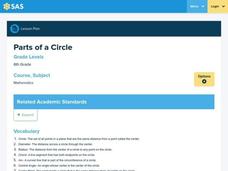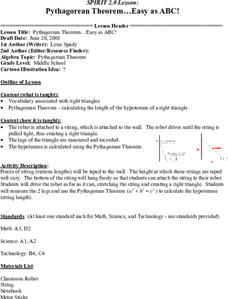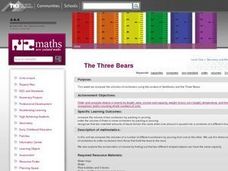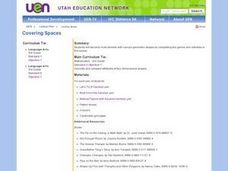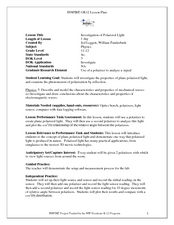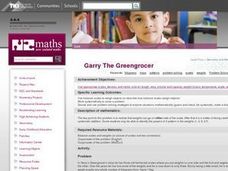Curated OER
Parts of a Circle
Sixth graders use yarn, paper plate, and other materials to identify parts of a circle. In this parts of a circle lesson plan, 6th graders identify the circumference, radius, diameter, and other parts of a circle.
Curated OER
Marshland Wonders
Students review the characteristics of wetlands and list their benefits. After viewing short videos, they identify the organims that make their home in wetlands and how they have adapted. They compare and contrast the characteristics...
Curated OER
Pythagorean Theorem
Students investigate the properties and idea of the Pythagorean Theorem. In this algebra lesson, students identify the different parts of a right triangle and relate it to the Pythagorean Theorem. They do a robotic experiment to...
Curated OER
Identifying Lines of Symmetry
Students calculate the lines of symmetry using polygons. In this geometry lesson, students graph, compare and estimate using collected data. They identify different attributes to the polygons based on their sides.
Curated OER
Figure It Out - Polygons
Sixth graders explore different polygons. In this polygon lesson, 6th graders examine a rhombus, quadrilateral, parallelogram, and rectangles. Students compare and contrast polygons and research shapes on the Internet.
Curated OER
Dividing Line Segments into n Congruent Parts
Students identify lines, and line segments. In this geometry lesson plan, students divide line segments into equal congruent parts. They complete a laboratory activity dealing with lines and segments.
Curated OER
Frictionally Speaking
Second graders investigate friction by pulling a cup of marbles across a variety of surfaces, without the marbles spilling out.
Curated OER
Introduction to Fractals: Infinity, Self-Similarity and Recursion
High schoolers think about several of the concepts from fractals, including recursion and self similarity. They use mathematical concepts of line segments, perimeter, area and infinity are used, and skill at pattern recognition is...
Curated OER
The Three Bears: Comparing and Ordering
Students explore comparing and ordering volume of containers. They use the context of Goldilocks and the Three Bears to compare the volume of various containers by packing or pouring.
Curated OER
Math: Geometric Fun and Games
Third graders discover geometric shapes by completing a series of games and activities. Using ropes with knots tied every foot, they make shapes such as squares, triangles, and hexagons. In pairs, 3rd graders use pattern blocks to...
Curated OER
Paper Airplane Activity
Ninth graders select and build one of five different paper airplane designs and test them for distance and for time aloft. Part of this activity is designed to explore NASA developed software, FoilSim, with respect to the lift of an...
Alabama Learning Exchange
Trapezoids: What's Equal or Right About Them?
Pupils explore the concept of trapezoids. In this trapezoids instructional activity, students identify legs and bases of a trapezoid. Pupils discuss the similarities and differences between isosceles trapezoids and right...
Alabama Learning Exchange
Is It a Triangle?
Young scholars explore the concept of triangle inequalities. For this triangle inequality lesson, students cut spaghetti noodles into given lengths. Young scholars use the noodles to complete a worksheet about triangle...
Curated OER
Lines, Rays, Line Segments, and Planes
Students are introduced to lines, rays, line segments and planes and study the differences between them. They also practice graphing lines, rays, line segments and planes
Curated OER
Investigating the Idea of Tan
Fifth graders use tan to solve problems involving right-angled triangles. They solve equations of the form tan(8) =a, for a between 180 degrees and 360 degrees. They state the value of tan (8) in special cases.
Curated OER
Geometry: Lesson 2
Eighth graders engage in a instructional activity that is concerned with examining two dimensional figures with different properties that include circles, triangles, queadrilaterals, etc... They identify the types of figures that is...
Curated OER
Polygons Defined
Fourth graders explore polygons. In this polygon lesson, 4th graders sort polygons according to their properties. Students discover the connection between polygons and the Greek language.
Curated OER
Investigation of Polarized Light
Students investigate how polorizers filter light. In this physics instructional activity, students record their data and plot their results using a computer logging software. They discuss practical applications of polarization.
Curated OER
Properties of Fractals
Students build a working definition of regular fractal, look carefully at the concepts of dimension and scale, and are introduced to logarithms. They solve simple exponential equations for the exponent both by trial and error and using...
Curated OER
Wheeling Around
Eighth graders explore the characteristics of a circle and the formulas to find circumference. They use a bicycle wheel to determine the circumference around a wheel. They utilize a worksheet imbedded in this plan which has a variety of...
Curated OER
Irregular Fractals
Students study and research irregular fractals and construct a few based on their research. Students practice pattern recognition skills and plane geometry skills calculating dimensions on the Fractured Pictures activity.
Curated OER
Garry The Greengrocer
Fourth graders are introduced to the problem by weighing objects on the balance scales. Use weights in both pans. (If you don't have access to scales use 2 containers and a child acting as the balance.) They then listen to the problem...
Curated OER
A Thoreau Look at Our Environment
Sixth graders write journal entries o school site at least once during each season, including sketched and written observations of present environment. They can use sample topographical maps and student's own maps. Students can use...
Curated OER
Laws of Reflection
Students experiment with mirrors to explore the Laws of Reflection. In this experimental lesson students develop their own experiments and follow a list of assigned steps then report what happens in their activity.
